Trauma Bonding: Definition, Stages, & Recovery
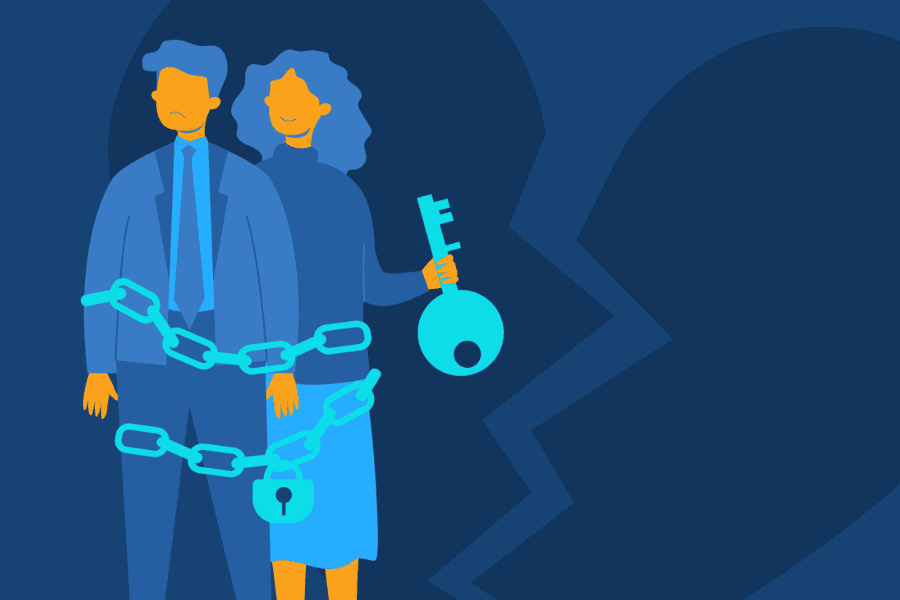

Trauma bonding is when a deep attachment develops from a cycle of physical and/or emotional abuse or trauma followed by positive reinforcement.
Trauma bonds most commonly develop in romantic relationships, and leaving these relationships can be very hard. It is difficult to process feelings after emotional or physical abuse, especially if the abuser acts loving afterward.
Often, trauma bonding occurs in romantic relationships, but it can also occur between:
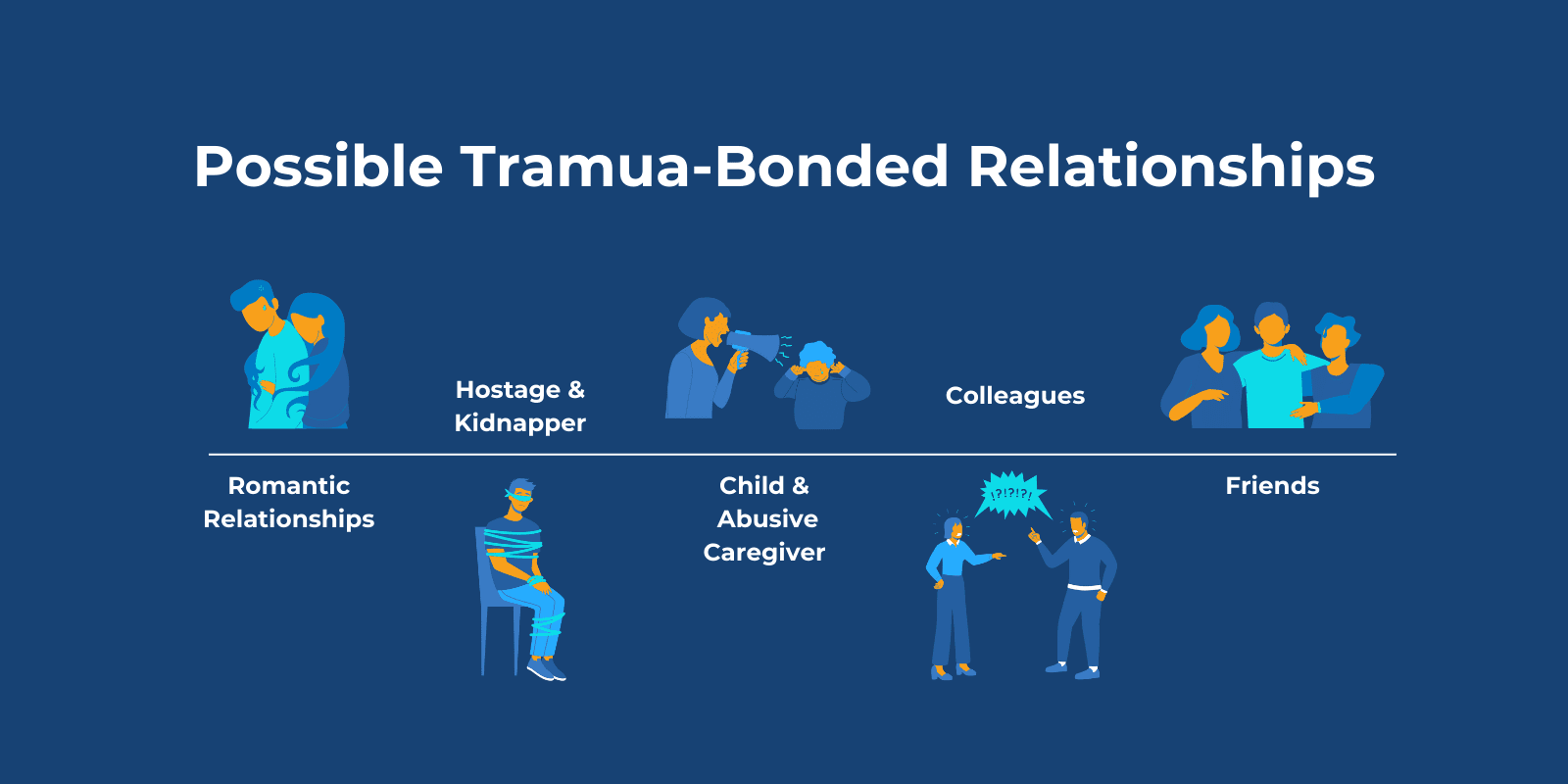
When a person experiences abuse, whether it be emotional abuse or physical, it can be tough to process the emotions that come along with it and cope.
With trauma bonding, one person abuses the other, inflicting trauma, but follows with positive reinforcement. For the other person, these traumatic experiences bring up a wide array of complicated emotions that can be difficult to cope with.
As a result, a person might start to feel bonded to the abusive person. They start to build an emotional attachment because they convince themselves it is love.
They tell themselves that their partner was just upset, that they will change, or think of them as the person they were before the abuse happened.
They get stuck in a cycle of abuse and positive reinforcement, constantly returning to the person even though they know they are being treated wrong.
Often, at the beginning of a relationship, it may seem very loving, affectionate, and passionate.
At the start, it can be hard to believe that your partner would do anything to hurt you. At some point, emotional, physical, or psychological abuse occurs.
It is hard to process, and the abuser often tries to talk their way out of it and manipulate their partner into thinking they love them, that they will change, and that it will never happen again.
This can confuse the other person, but they believe them because they hope it will get better.
This is how trauma bonds start.
It becomes a cycle where the abuser keeps doing the same thing but follows with positive reinforcement, giving their partner empty promises and convincing them they love them, only for it to happen again and again.
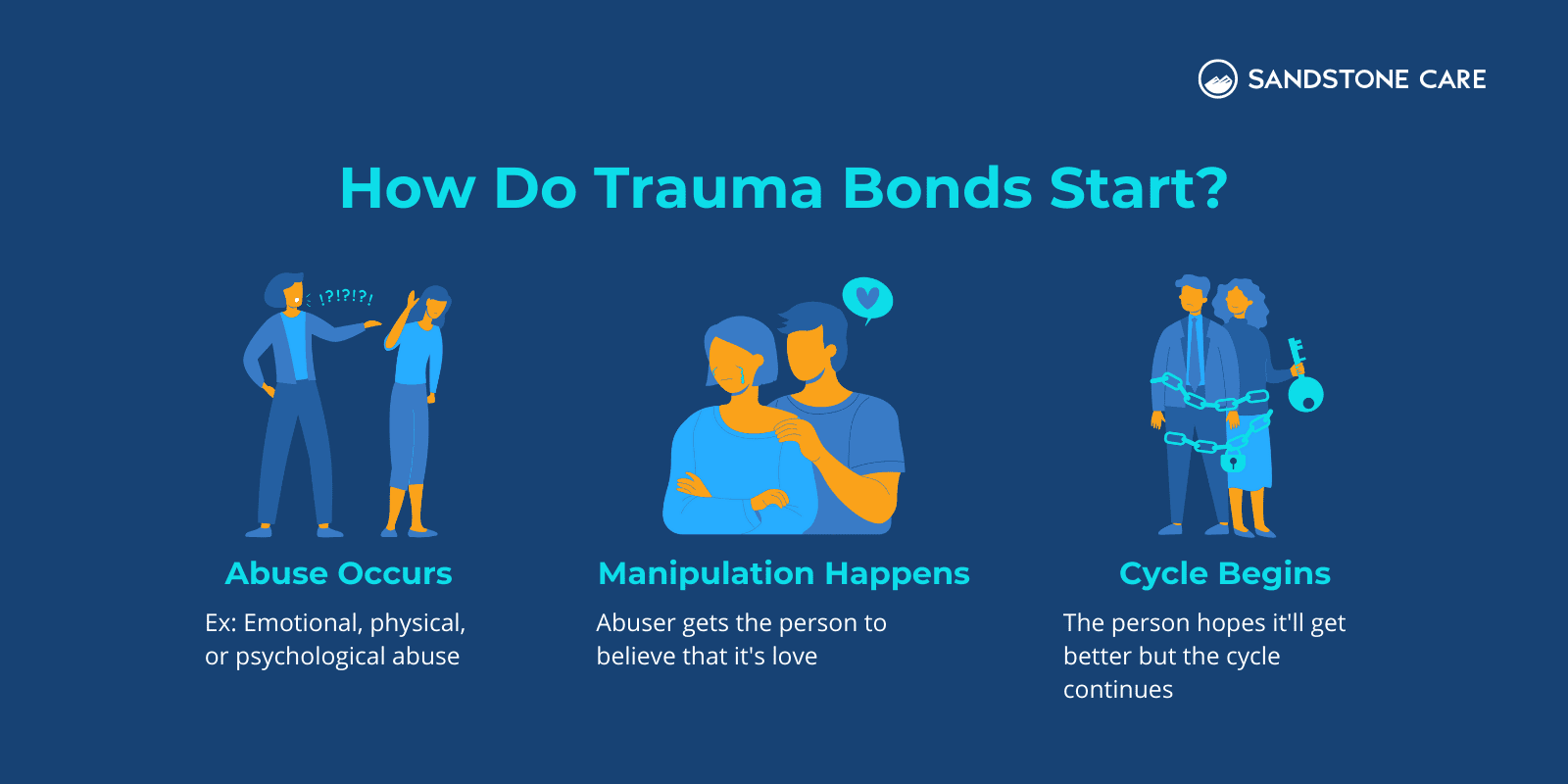
Trauma bonds are so strong and hard to leave because the people involved have intense and emotional experiences together.
The victim in a trauma-bonded relationship is manipulated into thinking that these intense feelings are love, making them look past the abusive behavior.
The feelings of fear and abandonment become stronger as the cycle continues, making the victim want to stay because it is all they know.
Yes, trauma bonding is an unhealthy emotional connection and harmful to a person’s physical health, mental health, and overall well-being.
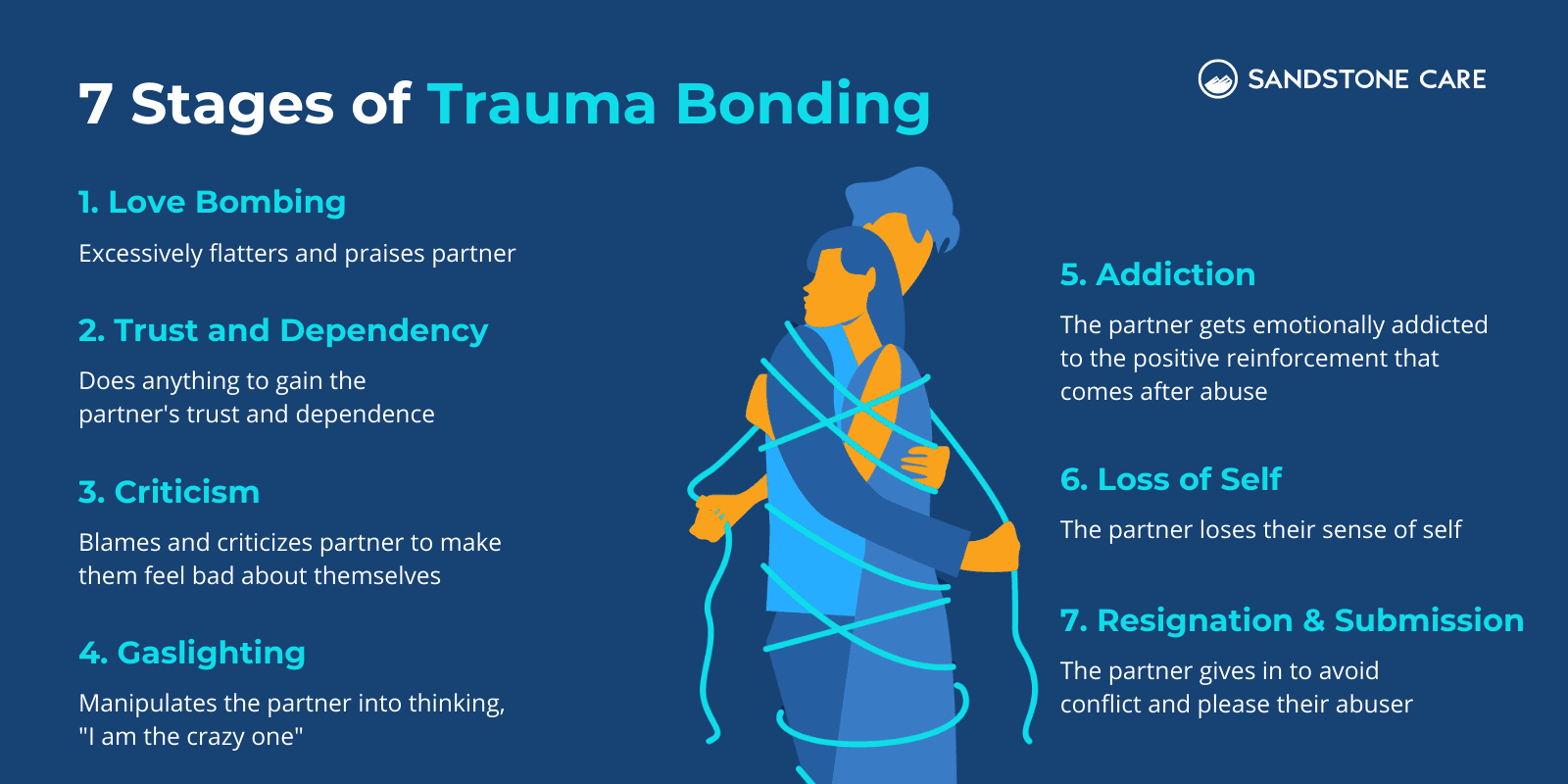
The 7 stages of the trauma bonding cycle include love bombing, trust and dependency, criticism, gaslighting, emotional addiction, loss of self, as well as resignation and submission. It’s important for victims to understand each stage to break free from the cycle and heal from the trauma inflicted on them throughout the relationship.
Keep reading to learn more about each stage of the trauma bonding cycle.
Love bombing occurs at the beginning of a relationship and involves excessive flattery and praise for the partner.
The person tries to win over the other with grand gestures and an overwhelming idea of love.
Love bombing can make the victim trust the other person and let their guard down. For the abuser, it makes them seem to have good intentions and puts a positive idea of them in their victim’s head.
In this stage, the perpetrator will do almost anything to make their partner trust them.
They often try to quickly advance the relationship, trying to ensure that the other person is dependent on them.
The abusive partner wants to make the other person think that they are meant for each other. This stage, along with love bombing, gives the victim an idea of the abuser, giving them hope for the future after the abuse happens.
After they have gotten a person’s trust, the abuser will start to pick apart their partner with the intention of making them feel negative about themselves.
When arguments occur, the perpetrator places the blame on the victim so that they will over-apologize and think something is wrong with them. They will doubt themselves and look to the abuser as a person who is there for them.
Gaslighting is a form of psychological abuse that makes the victim question reality.
When a person gaslights, they shift the blame onto the other person. They manipulate them into thinking that they’re wrong or “crazy.”
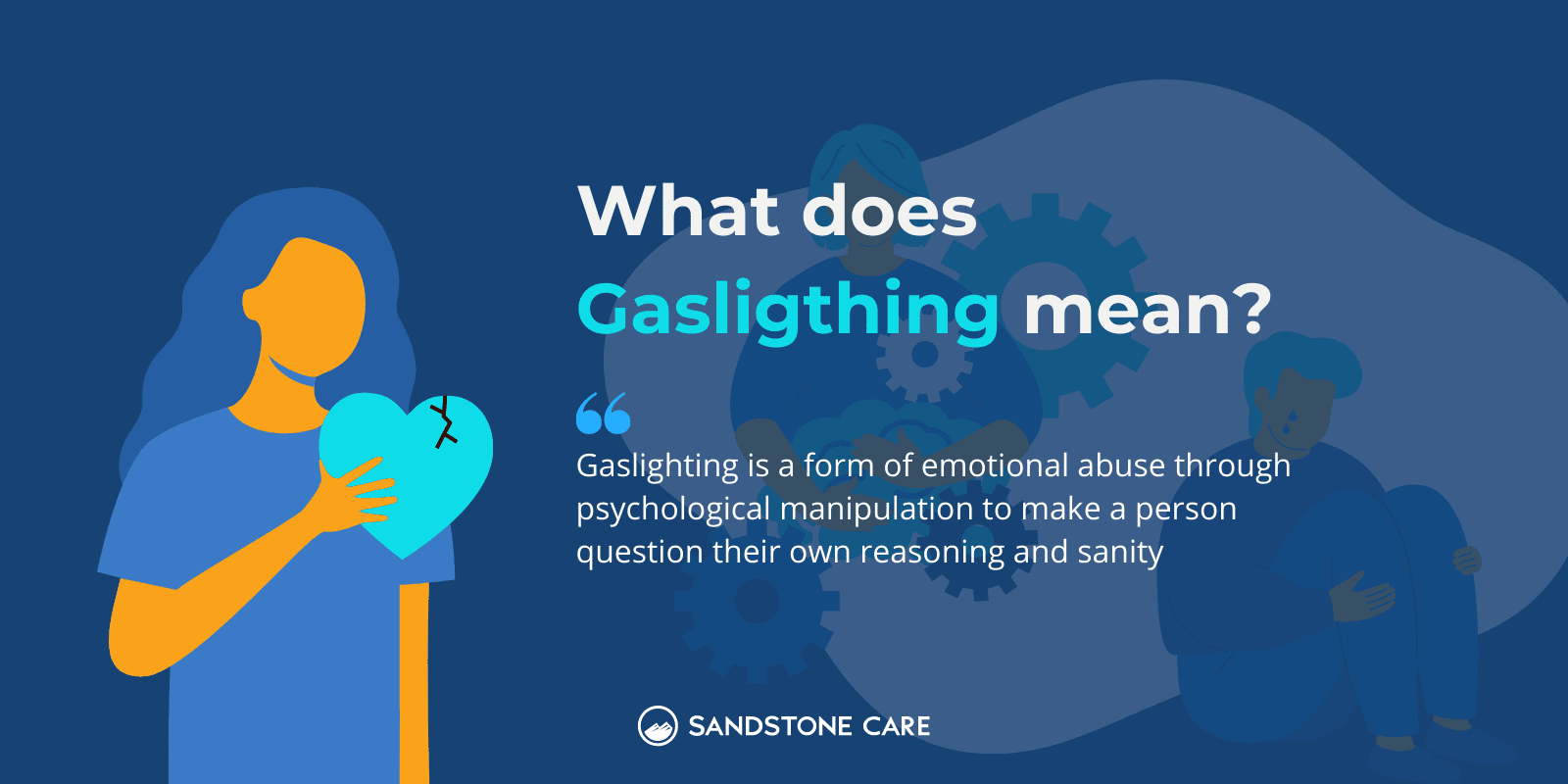
At this point, the target of abuse doesn’t know what to believe and gives in to avoid conflict.
It seems easier to do things the way the abuser wants than try to fight back, and it may seem that everything is good when they are not in conflict.
Over time, the person becomes more dependent and reliant on the abuser to please them and to avoid more conflict. They may have children with their partners, get married, and depend on them financially.
Resignation can also come from fear. They don’t want to escalate things or make things worse,e and it seems that their only choice is to do what makes their partner feel good.
When a person is in a trauma bond, it breaks down their confidence and sense of self.
They become disconnected, isolated, and at a loss when it comes to their self-identity.
Over time, sometimes for years, feelings of shame build-up, and a person can’t recognize who they are anymore. It can be very hard to move on from.
The stages of trauma bonds most commonly end up in a cycle.
After abuse, the love-bombing and positive reinforcement happens again, causing a sense of pleasure or satisfaction.
A person can essentially become addicted to this cycle.
Sometimes, the abuser may start to avoid their partner or stop giving them attention until they get what they want. When this happens, the other person feels that they are in control of the situation, making them feel that the abuser may truly love them.
A person can become emotionally addicted to a feeling or a response to their emotions.
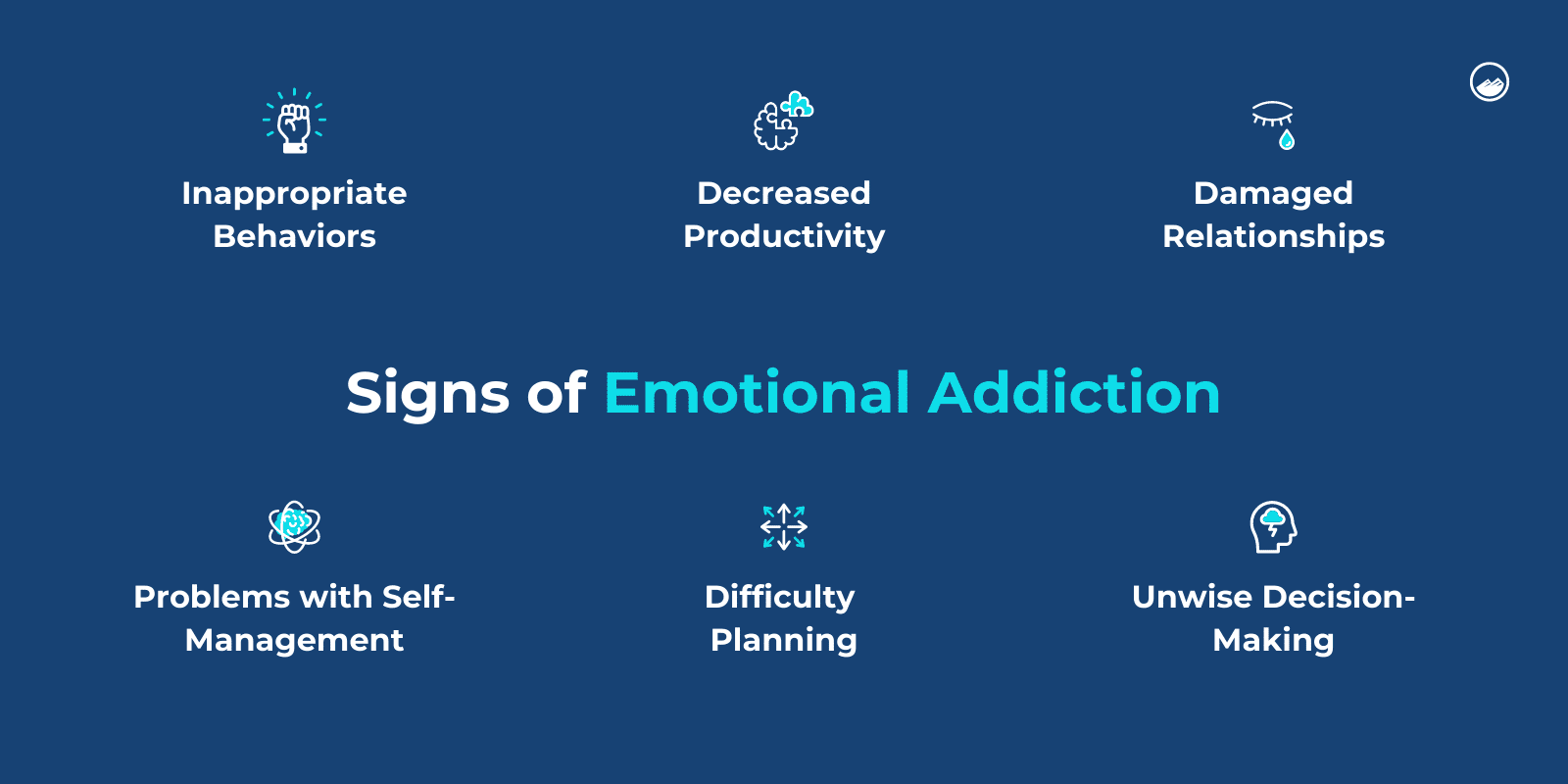
Signs that a person may have an emotional addiction can include:
Signs of trauma bonding can include:

A trauma bond is not a healthy relationship and is not real love.
In a healthy relationship, a person should feel safe and confident. With a trauma bond, a person often feels negative about themself, along with feelings of fear and anxiety.
Healthy relationships involve:
A trauma bond is usually built on control. But, because the abuser often makes their target feel that they love them with grand gestures of affection and attention.
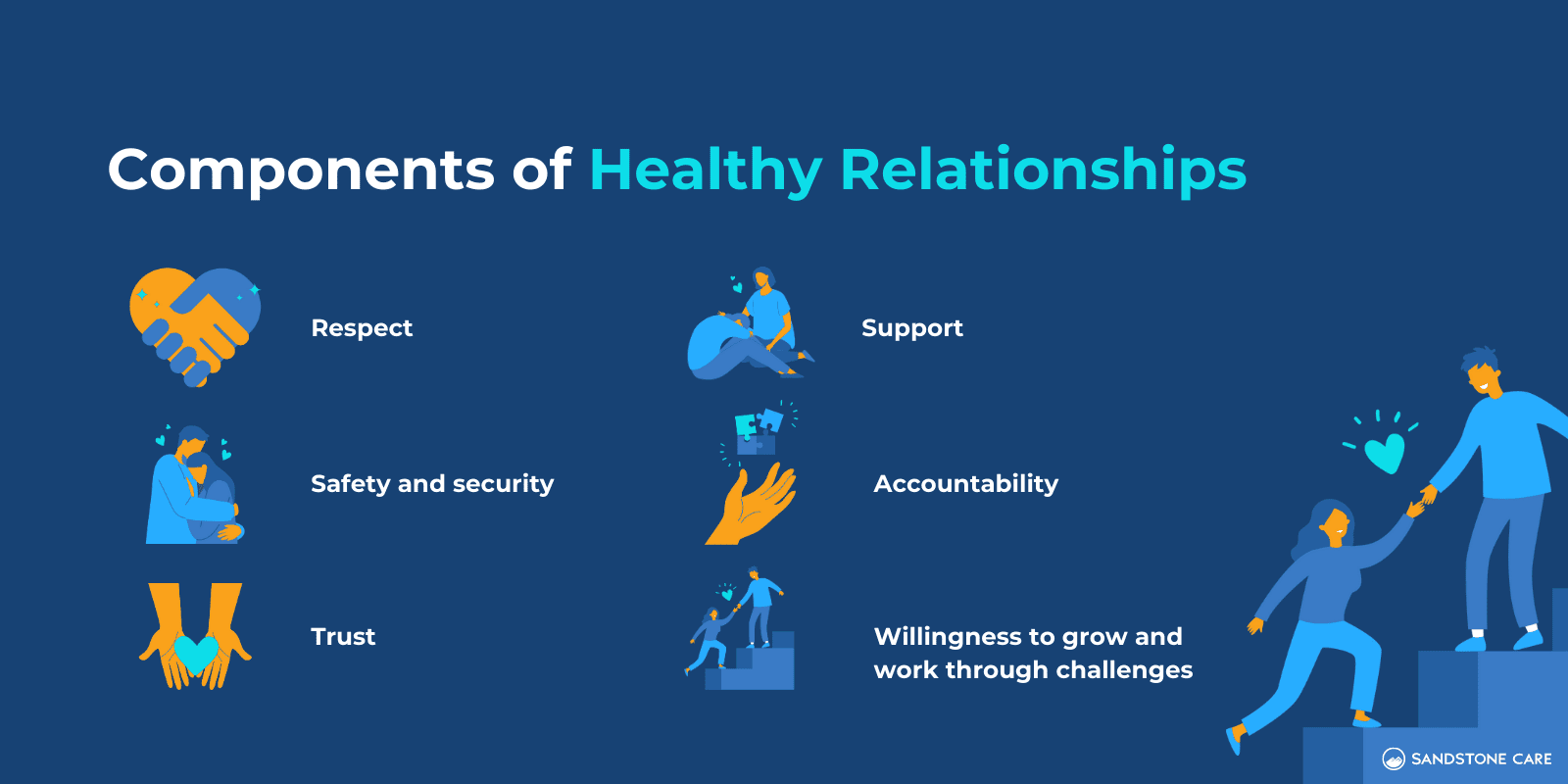
Trauma bonds can affect the brain by altering important neurochemical levels like dopamine and oxytocin.
When these neurochemicals are dysregulated, it can cause an emotional addiction, where a person can experience “cravings” for certain feelings that come from the cycle of the trauma bond.
It can also cause confusing and conflicting thoughts to the point where a person begins to justify and rationalize the abuse.
Additionally, trauma bonds can lead to problems that affect the brain, including:
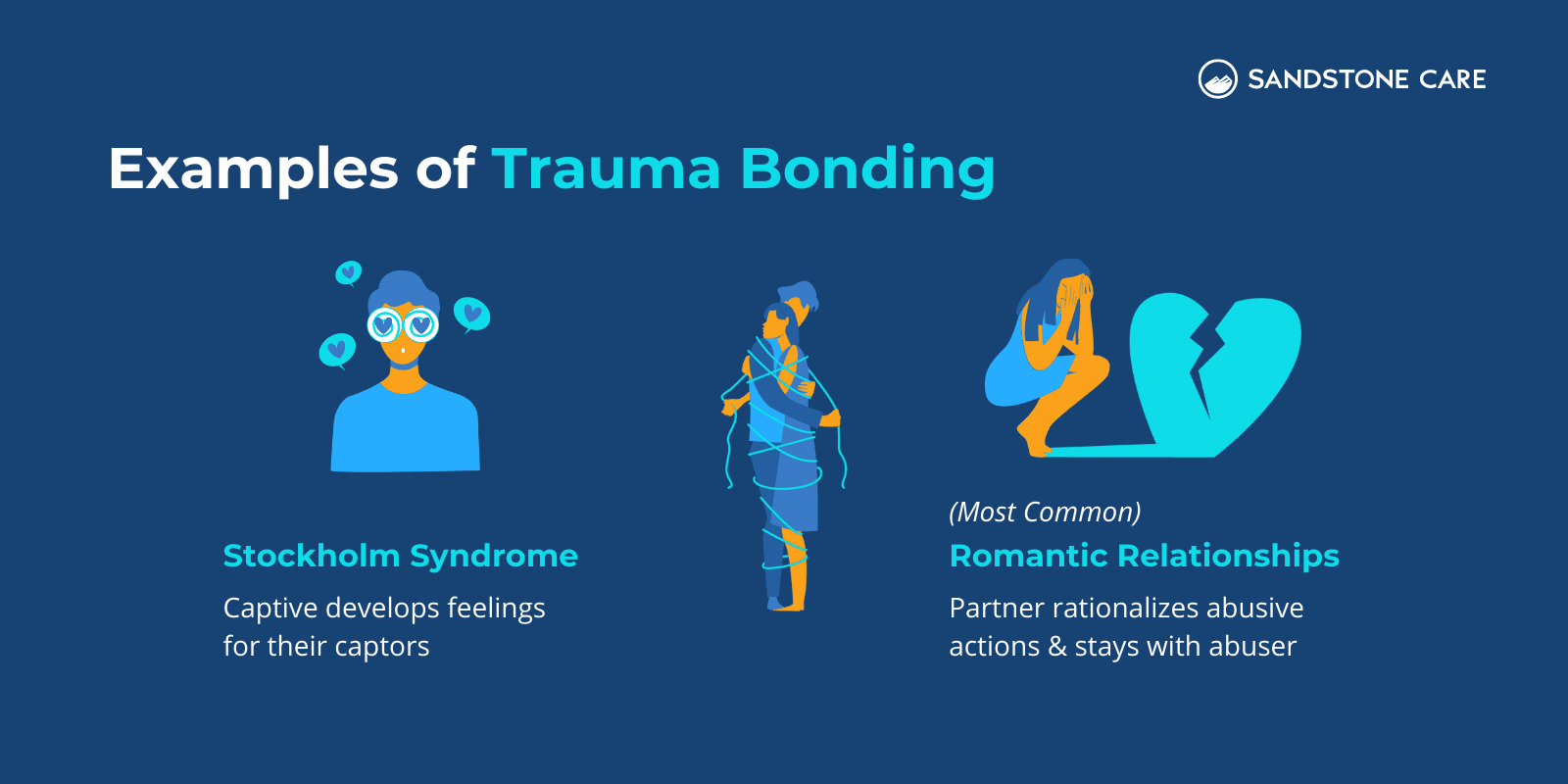
Stockholm syndrome is a trauma bond that refers to someone who is held captive and develops feelings for their captors.
Trauma bonds are also most common in romantic relationships, where a person’s partner is abusive, but the other person tries to rationalize it and stays with them.
Trauma bonding is present in abusive relationships that follow a cycle of abuse and positive reinforcement.
A person may be emotionally abusive and then say things like “I am going to change” or “I did it because I love you,” and shower their partner with affection and grand gestures, only for the abuse to happen again.
Trauma bonds do not end up in healthy relationships.
People involved in trauma bonds usually have hopes that it will be better in the end and that the person will change, but this is rarely the case.

It is important to know that if you are experiencing domestic violence, you can call the National Domestic Violence Hotline at 1-800-799-7233 or text “START” to 88788.
Breaking a trauma bond can take time and be very hard, but it is important to know that you are supported and that breaking the trauma bond is possible.
Some steps to take to break trauma bonds can include:
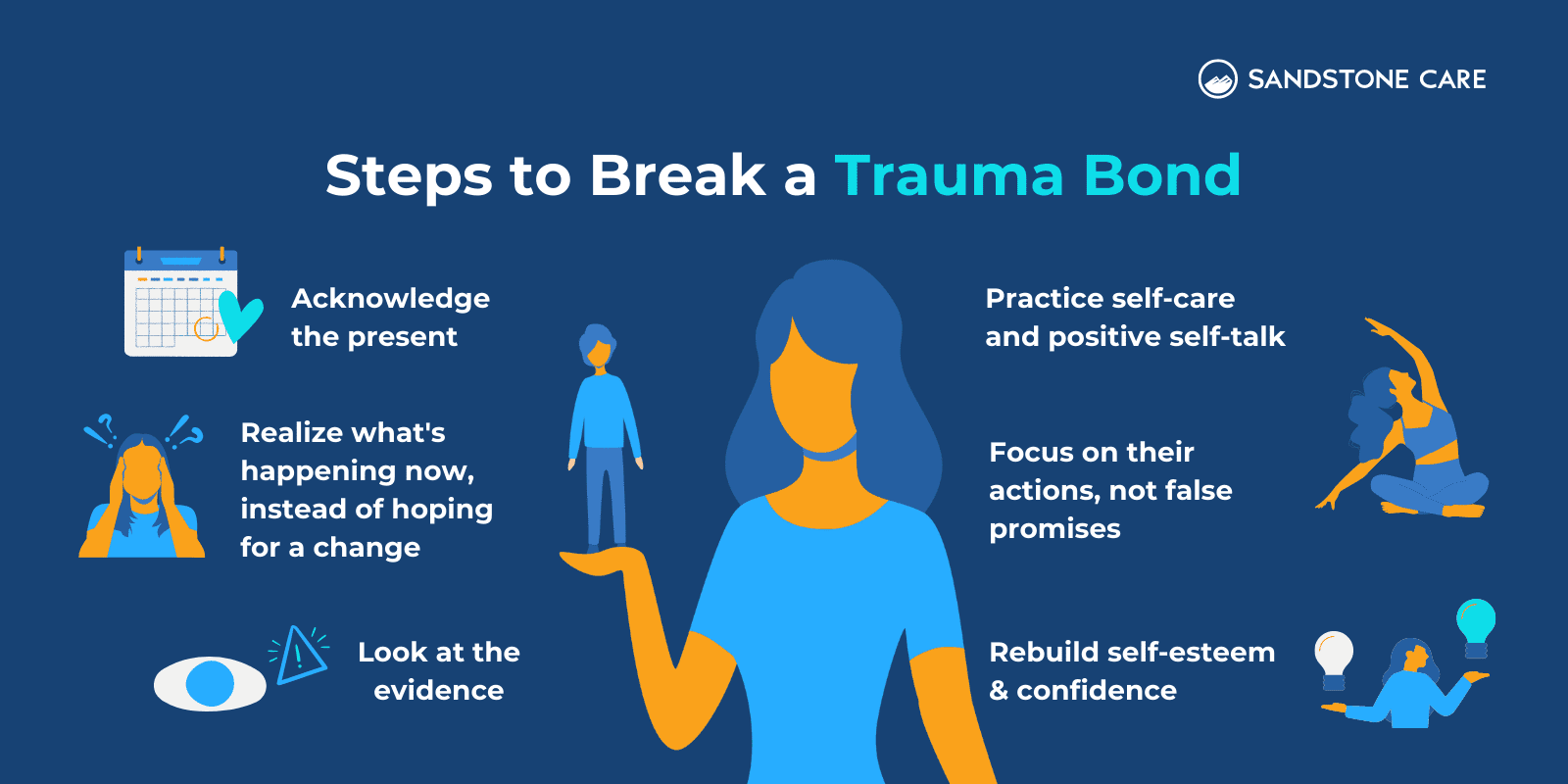
Breaking a trauma bond can feel extremely difficult.
However, it is important to know that it is possible and that this is the best choice for your health, happiness, and safety.
If you are trying to break a trauma bond, getting professional help can give you the support and guidance to take the necessary steps.
When a person breaks a trauma bond, they may experience physical symptoms that occur when they are no longer in this relationship.
Trauma bond withdrawal symptoms can include cravings for the person or the way you felt after making up with them, anxiety, feelings of panic, and flashbacks to the relationship. These symptoms can make you question your decision to leave or cut off contact, but will lessen with time.
They may experience:
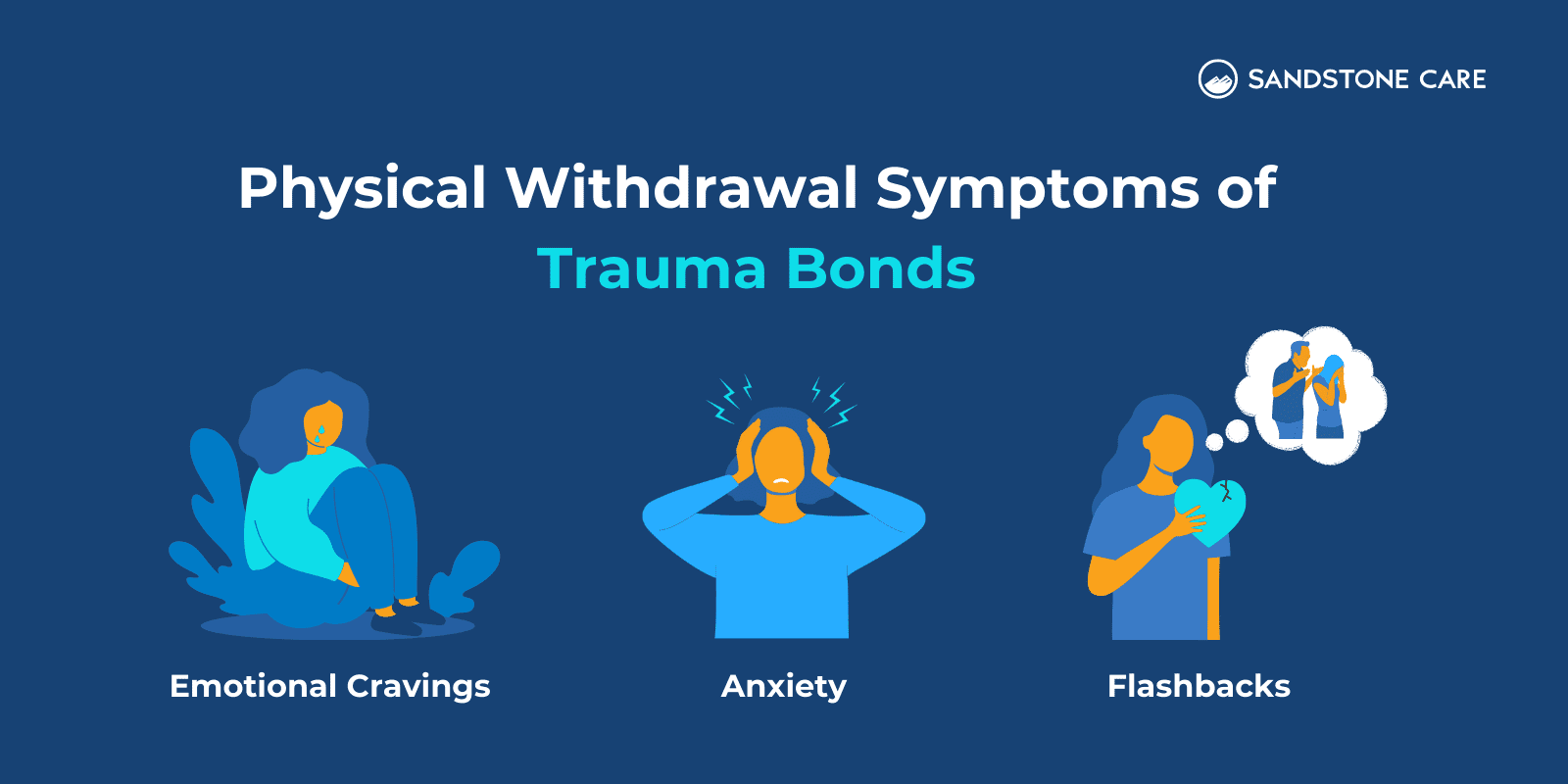
Detox refers to ridding the body of toxicity.
When a person detoxes from a trauma bond, they begin the release the weight and negativity that comes with it.
Some ways a person can work on detoxing from a trauma bond can include:
When a person is emotionally withdrawn, it can be very hard to express their emotions.
They may appear preoccupied, lack attention, isolate themselves, and have a hard time being affectionate or loving.
When a person is emotionally withdrawn, they bottle up their feelings and experiences.
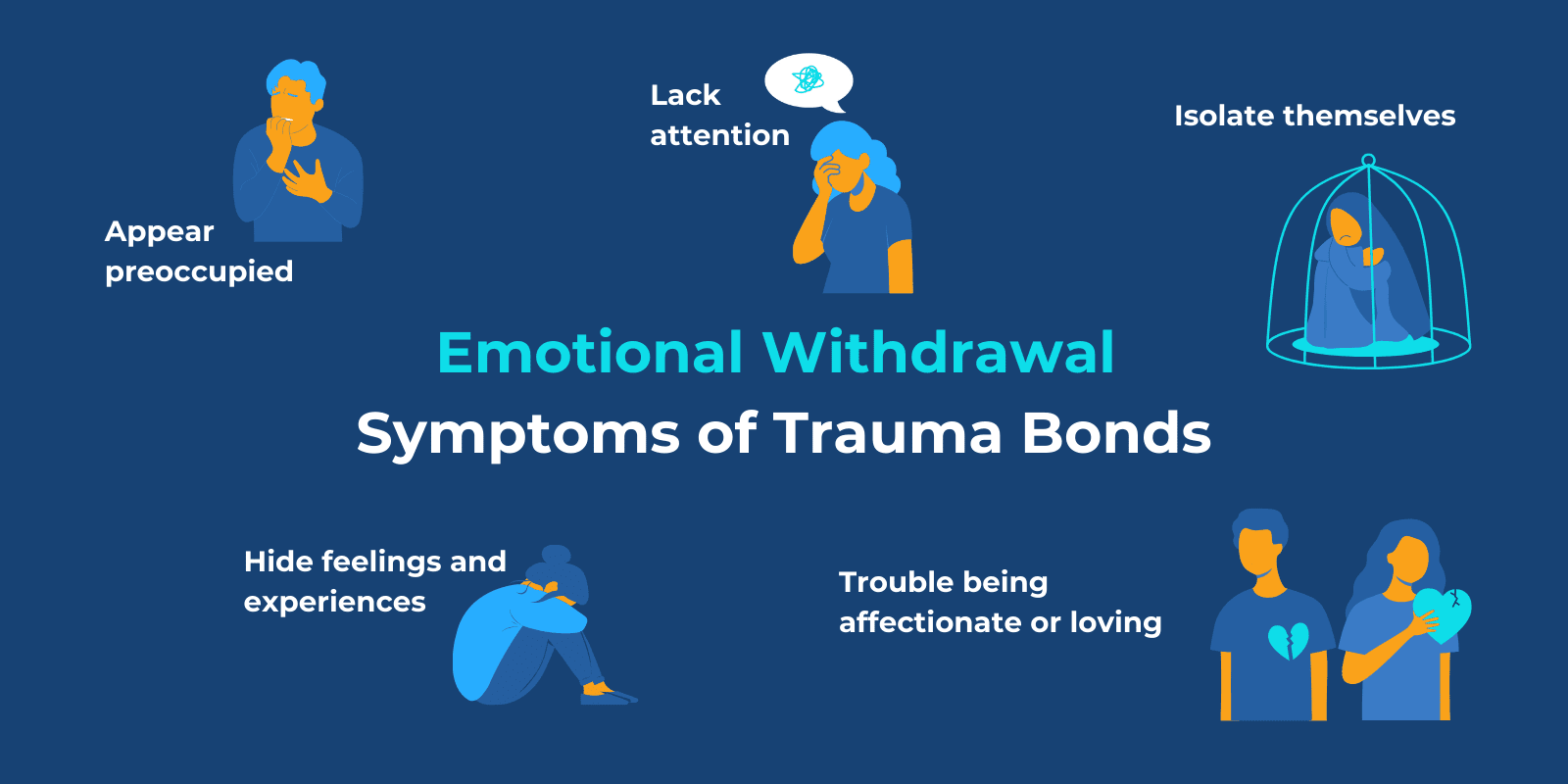
If you or a loved one are in a trauma bond, know that you are not alone.
Seeking help from someone you trust and connecting to a professional can help a person get treatment for trauma bonding.
Trauma bonding is usually treated through trauma-informed therapy.
Trauma therapy usually involves three main steps:
Therapy can be extremely helpful for individuals who are/were in a trauma bond.
Therapy can help a person process their experiences, learn how to cope, restructure negative thoughts and feelings, and help a person apply new strategies in their everyday life.
It is important to find a therapy that works for you and your needs. What works for one person may not work for another.

Trauma bonds could stick for some time, even if they happened a while ago.
However, a person can break free, heal, and move on after ending a trauma bond relationship.
Talk therapy is the most common and effective treatment for trauma bonding.
Common therapies include:
It is best to go to a therapist who understands trauma and has experience in trauma-informed therapy.
Support groups can also be very helpful in providing a safe space to go to share your experiences and relate to others.
The length of time it takes to heal from a trauma bond can be different from person to person.
There is no set amount of time it takes for a person to heal from a trauma bond.
Trauma can stay stored in the mind and body.
When a person releases trauma, they are able to feel their emotions and express their emotions.
Crying can also be a sign that trauma is being released. When trauma is stored, a person often represses their feelings and holds in a lot of their thoughts and emotions, which doesn’t allow them to fully process difficult experiences.
A person may also shake because they have all this negative energy built up.
On the other hand, a person can feel very relaxed with both their body and breathing because they are letting go of the things that are weighing them down. They may feel more light, free, and open.
FAQ
Our goal is to provide the most helpful information. Please reach out to us if you have any additional questions. We are here to help in any way we can.
Often, partners in a trauma bond mistake their emotional connection for real love when the feelings are a result of an abusive cycle.
However, trauma bonding will not turn into a healthy relationship as much as a person wants to believe it.
A person will often look past the fact that their relationship is harmful because they believe that it is real love.
Trauma bonding is a response to abuse.
Abuse can be emotional, psychological, or physical, but there is always abuse involved in trauma bonding.
Codependency is an unhealthy and dysfunctional relationship that involves an excessive amount of reliance on the other person to satisfy their needs.
A codependent relationship involves one person who sacrifices their needs while the other is the “taker.”
Codependency can be present in a trauma bond and vice versa.
Trauma dumping refers to oversharing difficult experiences and personal information without a person’s consent or at times that are not appropriate.
When a person trauma dumps, they are not considering the other person and how their conversation may affect them.
A person may trauma dump on a family member, friend, coworker, or even just an acquaintance.
Trauma bonds do not end in true love.
Many people who are in a trauma bond have hopes that it will end up in true love.
Trauma bonding can be used by narcissists as a way to manipulate their target and control them.
A trauma bond can actually make a narcissist feel good about themselves because they have control over the other person, and it often makes them feel comfortable.


A trauma bond is an unhealthy and dysfunctional attachment that comes from a cycle of abuse and positive reinforcement. Sandstone Care is here to support teens and young adults with mental health and substance use disorders.